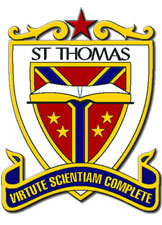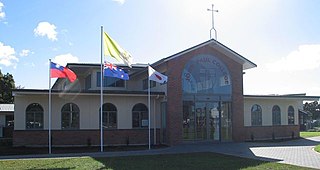The education system in New Zealand is a three-tier model which includes primary and intermediate schools, followed by secondary schools and tertiary education at universities and polytechnics. The academic year in New Zealand varies between institutions, but generally runs from early February until mid-December for primary schools, late January to late November or early December for secondary schools and polytechnics, and from late February until mid-November for universities.

Accounts payable (AP) is money owed by a business to its suppliers shown as a liability on a company's balance sheet. It is distinct from notes payable liabilities, which are debts created by formal legal instrument documents. An accounts payable department's main responsibility is to process and review transactions between the company and its suppliers and to make sure that all outstanding invoices from their suppliers are approved, processed, and paid. Processing an invoice includes recording important data from the invoice and inputting it into the company's financial, or bookkeeping, system. After this is accomplished, the invoices must go through the company's respective business process in order to be paid.

The Department of Corrections is the public service department of New Zealand charged with managing the New Zealand corrections system. Corrections' role and functions were defined and clarified with the passing of the Corrections Act 2004. In early 2006, Corrections officially adopted the Māori name Ara Poutama Aotearoa.

Anne Merrilyn Tolley is a New Zealand politician and former member of the New Zealand House of Representatives representing the National Party. She was New Zealand's first female Minister of Education from 2008 to 2011 and the first Minister for Children from 2016 to 2017. During the Fifth National Government, she was also Minister of Social Development, Minister of Corrections, Minister of Police and Minister of Local Government. She served as Deputy Speaker of the House of Representatives from 2017 to 2020. She is currently the Chair of the Commission overseeing the Tauranga City Council, which was appointed after a review in 2020 identified significant governance problems within the Council.

Christchurch Girls' High School in Christchurch, New Zealand, was established in 1877 and is the second oldest girls-only secondary school in the country, after Otago Girls' High School.

Ao Tawhiti or Ao Tawhiti Unlimited Discovery is a state area school in Christchurch, New Zealand. It was established by the merging of two separate Christchurch inner city schools; the primary school Discovery 1 and the secondary school Unlimited Paenga Tawhiti.

St Peter's College is a Catholic secondary school for boys, located in Auckland, New Zealand, in the central city suburb of Grafton. With a roll of over 1300, the school is one of the largest Catholic schools in New Zealand. St Peter's College was established in 1939 as a successor of Auckland's earliest school and of St Peter's School, founded in 1857. The Outhwaite family, who acquired the land around 1841, donated the site of the college. The Christian Brothers provided staff for the college for 70 years.
The provision of state education in New Zealand developed from ideas about democratic and progressive education in the late nineteenth century. The creation of an education system that aimed to reduce inequalities and enable social mobility was an important goal for New Zealand's early educational reformists.
School fees in New Zealand is a term referring to monetary payments by parents or guardians to their child's school.

St Thomas of Canterbury College is a college for year 7 to 13 boys and offers a Catholic education to its students. It is located in Christchurch, New Zealand. The college is integrated into the state education system under an integration agreement which was first entered into by the Christian Brothers and the Government of New Zealand on 11 November 1981 under Section 7 of the Private Schools Conditional Integration Act 1975. St Thomas of Canterbury College is located in the Christchurch suburb of Sockburn.

John Paul College is a Catholic secondary school in Rotorua, New Zealand. The co-educational school caters for students in years 7 to 13. It was opened in 1987 and combined two existing schools, Edmund Rice College and MacKillop College. The school was founded to serve the Catholic families of Rotorua. John Paul College was named for Pope John Paul II.

Patricia Hekia Parata is a former New Zealand politician and former member of the New Zealand House of Representatives, having been elected to parliament in the 2008 general election as a member of the New Zealand National Party. She served as the Minister of Education in the Fifth National Government.

Sir Harawira Tiri Gardiner was a New Zealand soldier, public servant, and writer. He was Māori, of Ngāti Awa, Ngāti Pikiao, Whakatōhea, and Te Whānau-ā-Apanui descent.
The following lists events that happened during 2012 in New Zealand.
Charter schools in New Zealand, also known as partnership schools or kura hourua, were schools that received government funding similar to state schools but were subject to fewer rules and regulations from the Ministry of Education. They were free and open for any students to attend. Charter schools had the autonomy to set their own curriculum, qualifications, pay rates for teachers, school-hours and school terms. The schools were operated by sponsors such as Māori Iwi, not-for-profit organisations, businesses or existing education providers.
In New Zealand, a state-integrated school is a former private school which has integrated into the state education system under the Private Schools Conditional Integration Act 1975, becoming a state school while retaining its special character. State-integrated schools were established by the Third Labour Government in the early 1970s as a response to the near-collapse of the country's then private Catholic school system, which had run into financial difficulties.
The Phoenix pay system is a payroll processing system for Canadian federal government employees, provided by IBM in June 2011 using PeopleSoft software, and run by Public Services and Procurement Canada. The Public Service Pay Centre is located in Miramichi, New Brunswick. It was first introduced in 2009 as part of Prime Minister Stephen Harper's Transformation of Pay Administration Initiative, intended to replace Canada's 40-year old system with a new, cost-saving "automated, off-the-shelf commercial system." By July 2018, Phoenix has caused pay problems to close to 80 percent of the federal government's 290,000 public servants through underpayments, over-payments, and non-payments. The Standing Senate Committee on National Finance, chaired by Senator Percy Mockler, investigated the Phoenix Pay system and submitted their report, "The Phoenix Pay Problem: Working Towards a Solution" on July 31, 2018, in which they called Phoenix a failure and an "international embarrassment". Instead of saving $70 million a year as planned, the report said that the cost to taxpayers to fix Phoenix's problems could reach a total of $2.2 billion by 2023.
The information and communications technology industry in New Zealand is a rapidly growing sector. The technology sector overall employs over 120,000 people, and technology is New Zealand's third largest export sector, accounting for $8.7 billion of exports, with information technology creating 50,000 full time jobs, and about $1 billion in IT services exports.









